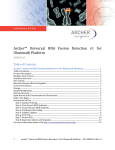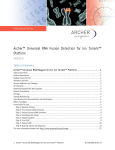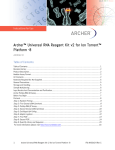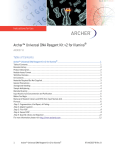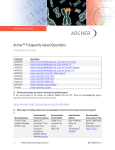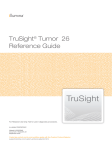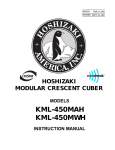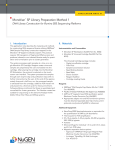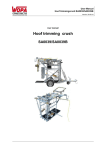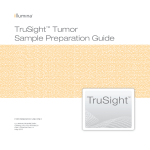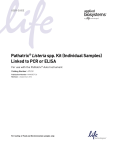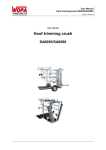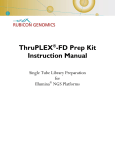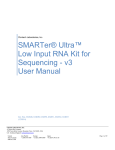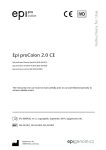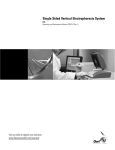Download IFU-AK0024-8 Archer Universal RNA Reagent Kit
Transcript
Instructions for Use Archer™ Universal RNA Reagent Kit for Illumina® Platform AK0024-8 Table of Contents Archer™ Universal RNA Reagent Kit for Illumina® Platform ...................................... 1 Table of Contents ................................................................................................................................................................... 1 Product Description ............................................................................................................................................................... 2 Modular Assay Format ........................................................................................................................................................... 2 Workflow Overview ................................................................................................................................................................ 2 Version Additions and Changes…………………….………………………………………………………………………………..……...3 Kit Contents ............................................................................................................................................................................ 3 Materials Required But Not Supplied .................................................................................................................................. 3 General Precautions .............................................................................................................................................................. 3 Storage .................................................................................................................................................................................... 4 Sample Multiplexing............................................................................................................................................................... 4 Barcode Diversity ................................................................................................................................................................... 4 Input Nucleic Acid Concentration and Purification............................................................................................................ 4 Before You Begin .................................................................................................................................................................... 5 Instructions for Use ............................................................................................................................................................... 5 Step 1: Random Priming ................................................................................................................................................... 5 Step 2: First Strand cDNA Synthesis ............................................................................................................................. 6 Step 3: Second Strand cDNA Synthesis ......................................................................................................................... 6 Step 4: End Repair/dA-Tailing .......................................................................................................................................... 7 Step 5: Adapter Ligation ................................................................................................................................................... 8 Step 6: First PCR ............................................................................................................................................................... 9 Step 7: Second PCR ........................................................................................................................................................ 10 Step 8: Quantify Library and Sequence ........................................................................................................................ 12 For more information please visit http://www.enzymatics.com/archer ................................................................... 14 1 Archer™ Universal RNA Reagent Kit for Illumina® Platform IFU-AK0024-8 Rev. B Product Description Gene fusions represent an important class of genomic rearrangements in translational research. The Archer™ Universal RNA Reagent Kits and FusionPlex™ assays utilize the power of next-generation sequencing to improve the detection of genomic rearrangements over traditional methods such as immunohistochemistry (IHC) and fluorescence in situ hybridization (FISH). Modular Assay Format The Archer™ Universal RNA Reagent Kit used in conjunction with Archer™ Assays and MBC Adapters, allows users to construct Illumina® MiSeq®-ready libraries from total nucleic acid or RNA samples. For Research Use Only. Not for use in diagnostic procedures. Workflow Overview 2 Archer™ Universal RNA Reagent Kit for Illumina® Platform IFU-AK0024-8 Rev. B Version Additions & Changes Added multiplexing recommendations for the Archer™ FusionPlex™ Heme and Sarcoma Panels Instructions included for the preparation of PhiX to achieve a final concentration of 10 pM in 0.2 N NaOH starting from a 10 nM stock solution • • Kit Contents 1. 2. 3. 4. 500 mM Tris-HCl, pH 8.0 (SA0020) Ultra Pure Water (SA0021) Ultra Pure Water for Ethanol Dilution (SA0022) Lyophilized Reagents: a. Step 1: Random Priming (SA0001) b. Step 2: First Strand cDNA Synthesis (SA0002) c. Step 3: Second Strand cDNA Synthesis (SA0003) d. Step 4: End repair/dA-tailing (SA0004) e. Step 5: Adapter Ligation (SA0005) f. Step 6: First PCR (SA0009) g. Step 7: Second PCR (SA0013) Materials Required But Not Supplied 1. 2. 3. 4. 5. 6. 7. 8. Archer™ MBC Adapters for Illumina® Archer™ FusionPlex™ Assay (Cat# AK0028-8, AK0029-8, AK0032-8) Agencourt® AMPure® XP Beads (Cat# A63881) Life Technologies™ DynaMag™ (Cat# 12331D) 100% ethanol (ACS grade) KAPA Biosystems® Library Quantification Kit - Illumina®/Universal (Cat# KK4824) Custom Primer Panels, designed at http://assay.enzymatics.com If nucleic acid is from FFPE tissue, it is recommended to use Agencourt® FormaPure® (Cat# A33342) for extraction General Precautions • • • • • • 3 Read the entire protocol before beginning. Take note of stopping points where samples can be frozen at -20°C and plan your workflow accordingly. Use good laboratory practices to minimize cross-contamination of nucleic acid products. Always use PCR tubes, microfuge tubes and pipette tips that are certified sterile, DNase- and RNasefree. Before starting, wipe down work area and pipettes with an RNase and DNA cleaning product such as RNase Away™ (Molecular BioProducts, Inc. San Diego, CA). For consistent library amplification, ensure the thermal cycler used in this protocol is in good working order and has been calibrated to within the manufacturer’s specifications. Archer™ Universal RNA Reagent Kit for Illumina® Platform IFU-AK0024-8 Rev. B Storage All components of the Archer™ Universal RNA Reagent Kit (Part # AK0024-8) should be stored at 4°C. Allow pouches to warm to room temperature before opening. Sample Multiplexing In order to efficiently utilize the throughput of the MiSeq®, multiple samples should be sequenced simultaneously. Samples can be identified through a unique nucleotide sequence that is part of the adapter attached to the nucleic acid molecule in a given sample during library construction, and which is subsequently read during the sequencing process. The unique nucleotide sequence is often termed an “index”. Archer™ Universal RNA Reagent kits for Illumina® utilize 2 indices in combination to distinguish between samples. The first index is added just before Step 5 (Adapter Ligation) and is embedded in the Archer™ MBC Adapters for Illumina®. The second index is added in Step 7 (Second PCR) and is embedded in MiSeq® Index 1 Primers within the Second PCR reaction. In order to maintain appropriate coverage depth, it is recommended to cap each MiSeq® run at 30-48 samples per lane. In general larger panels with more targets will require higher sequencing coverage depth and should be run with fewer samples per sample. Below are some recommendations for panels of different sizes: Archer™ Panel # of Targets/Assay Recommended # of Samples/Lane FusionPlex™ ALK, RET, ROS1 Panel v2 FusionPlex™ Heme Panel FusionPlex™ Sarcoma Panel 29 132 134 30-40 20-30 20-30 Barcode Diversity The Illumina® MiSeq® will work best when index diversity within a run is high. For example, if eight samples are included in a run, and the user chooses to use only one MBC Adapter paired with eight different MiSeq® Index 1 Primers, the run may fail due to low barcode diversity. In this example it is best to use eight different Archer™ MBC Adapters paired with eight different MiSeq® Index 1 Primers. Input Nucleic Acid Concentration and Purification • • • • 4 Total nucleic acid is the preferred input for this assay. DO NOT treat the extracted total nucleic acid with DNase, as this will critically reduce the quality of RNA in the sample. If nucleic acid is from FFPE tissue, it is recommended to use Agencourt® FormaPure® (A33342) for extraction. When possible, it is recommended to increase the total nucleic acid input, which will increase library complexity and improve the sensitivity of the assay. If higher library complexity is desired, the assay can tolerate up to 250 ng of total nucleic acid. Archer™ Universal RNA Reagent Kit for Illumina® Platform IFU-AK0024-8 Rev. B • • • The minimum recommended input for the assay is 20 ng of total nucleic acid. Alternatively, 10 ng of RNA may be used. Efficient library preparation can be achieved with as little as 2 ng of total nucleic acid, provided that the starting material is of high quality and is not degraded. However, reduced input will decrease library complexity due to the restricted amount of starting unique target molecules. When using less than 10 ng of input material the PCR cycling conditions (Steps 6 and 7) may need to be altered. The use of EDTA-containing buffers in this protocol may result in lower library yields. Be sure to use buffers that do not contain EDTA (i.e. use Tris-HCl and not Tris-EDTA buffer). Before You Begin • • Make fresh 10 mM Tris-HCl. o Mix 20 µL 500 mM Tris-HCl, pH 8.0 (SA0020) with 980 µL Ultra Pure Water (SA0021). Make fresh 70% ethanol. o Add 14 mL 100% ethanol (ACS grade; not included) to entire bottle containing Ultra Pure Water for Ethanol Dilution (SA0022). o Note the date on which ethanol is added, 70% ethanol is appropriate for use for one week after mixing. When not in use, tightly close the bottle cap to ensure minimal evaporation. Instructions for Use Step 1: Random Priming 1.1. Pre-heat thermal cycler to 65°C with a heated lid. 1.2. Gently open the Random Priming (SA0001) foil pouch by tearing along the indents located at the top of the silver package. 1.3. Remove the green 8-tube strip. Each tube in the strip provides a single reaction. 1.4. Centrifuge briefly to ensure lyophilized material is in the bottom of the tube. 1.5. If you would like to use fewer than eight reactions, detach the appropriate number of tubes carefully using clean scissors or a new razor blade. Store the remaining unused tubes in the sealed foil pouch with desiccant provided at 4°C. 1.6. Place the tubes on ice and to each add: Ultra Pure Water (SA0021) Purified Total Nucleic Acid Total 20 – X µL X µL 20 µL 1.7. After the lyophilized pellet dissolves, gently pipet up and down 6 – 8 times and briefly spin down. 1.8. Transfer the tubes from ice to the thermal cycler and incubate at 65°C for 5 minutes. 1.9. Remove tubes from thermal cycler and place on ice for 2 minutes, then briefly centrifuge before proceeding with First Strand cDNA Synthesis. 5 Archer™ Universal RNA Reagent Kit for Illumina® Platform IFU-AK0024-8 Rev. B Step 2: First Strand cDNA Synthesis 2.1. Gently open the First Strand cDNA Synthesis (SA0002) foil pouch by tearing along the indents located at the top of the silver package. 2.2. Remove the purple 8-tube strip. Each tube in the strip provides a single reaction. 2.3. Centrifuge briefly to ensure lyophilized material is in the bottom of the tube. 2.4. If you would like to use fewer than eight reactions, detach the appropriate number of tubes carefully using clean scissors or a new razor blade. Store the remaining unused tubes in the sealed foil pouch with the desiccant provided at 4°C. 2.5. Place the First Strand cDNA Synthesis tubes on ice and transfer 20 µL of the Random Priming mixture (Step 1.9) to the lyophilized First Strand cDNA Synthesis pellet and mix well by pipetting up and down. Spin briefly to collect contents at the bottom of the tube. 2.6. Place the tubes into a thermal cycler with a heated lid set to ≥100°C and incubate as follows: Step 1 2 3 4 Incubation Temperature 25°C 42°C 80°C 4°C Incubation Time 10 min 30 min 20 min Hold 2.7. Remove the PCR tubes from the thermal cycler and place on ice. Step 3: Second Strand cDNA Synthesis 3.1. Gently open the Second Strand cDNA Synthesis (SA0003) foil pouch by tearing along the indents located at the top of the silver package. 3.2. Remove the 3.3. Centrifuge briefly to ensure lyophilized material is in the bottom of the tube. 3.4. If you would like to use fewer than eight reactions, detach the appropriate number of tubes carefully using clean scissors or a new razor blade. Store the remaining unused tubes in the sealed foil pouch with the desiccant provided at 4°C. 3.5. To the Second Strand cDNA Synthesis tube on ice add: 3.6. 6 8-tube strip. Each tube in the strip provides a single reaction. Ultra Pure Water (SA0021) First Strand cDNA Synthesis reaction (Step 2.7) 20 µL 20 µL Total 40 µL Mix well by pipetting gently up and down 6 – 8 times. Spin briefly to collect contents at the bottom of the tube. Archer™ Universal RNA Reagent Kit for Illumina® Platform IFU-AK0024-8 Rev. B 3.7. Incubate at 16°C for 1 hour. If a thermal cycler is used for the incubation do not use a heated lid or close the heated lid. Do not allow the temperature to rise above 16°C. Stopping point: It is OK to stop and store the library at -20°C. Step 4: End Repair/dA-Tailing 4.1. Gently open the End Repair/dA-Tailing (SA0004) foil pouch by tearing along the indents located at the top of the silver package. 4.2. Remove the blue 8-tube strip. Each tube in the strip provides a single reaction. 4.3. Centrifuge briefly to ensure lyophilized material is in the bottom of the tube. 4.4. If you would like to use fewer than eight reactions, detach the appropriate number of tubes carefully using clean scissors or a new razor blade. Store the remaining unused tubes in the sealed foil pouch with the desiccant provided at 4°C. 4.5. Transfer 40 µL of the Second Strand cDNA Synthesis reaction (Step 3.7) into tube containing lyophilized End Repair/dA-Tailing (SA0004) reagents and mix well by pipetting up and down 6 – 8 times. Spin briefly to collect contents at the bottom of the tube. 4.6. Incubate the reaction in a thermal cycler with a heated lid set to ≥100°C and incubate as follows: Step 1 2 3 4 Incubation Temperature 12°C 37°C 72°C 4°C Incubation Time 15 min 15 min 15 min Hold 4.7. Ensure the reaction cools to 4°C and briefly centrifuge End Repair reaction before proceeding. 4.8. Gently open a pouch of Archer™ MBC Adapters for Illumina® by tearing along the indents located at the top of the silver package. 4.9. Remove the clear 8-tube strip from the foil pouch. Each tube in the strip provides a single reaction and each tube contains a different Illumina® MBC Adapter. (For example, reactions 1 through 8 correspond to MBC Adapters 1 through 8). 4.9.1. CRITICAL: Upon removing the 8-tube strip from the pouch, position the tubes with the hinges to the back and use a permanent marker to label the tubes 1 through 8 from left to right as shown below. Be sure to label and track the index number added to each sample from this point forward. 7 Archer™ Universal RNA Reagent Kit for Illumina® Platform IFU-AK0024-8 Rev. B 4.10. Centrifuge briefly to ensure lyophilized material is in the bottom of the tube. 4.11. If you would like to use fewer than eight reactions, detach the appropriate number of tubes carefully using clean scissors or a new razor blade. Store the remaining unused tubes in the sealed foil pouch with the desiccant provided at 4°C. Be sure to track which indices were used to ensure index compatibility when used in later experiments. 4.12. To the Archer™ MBC Adapters tube for Illumina® tube on ice add: Ultra Pure Water (SA0021) End Repaired/dA-tailed DNA (Step 4.7) Total 10 µL 40 µL 50 µL 4.13. Allow the pellet to dissolve and then pipet up and down 6 – 8 times to mix. Spin briefly to collect contents at the bottom of the tube. 4.14. Immediately proceed to Step 5. Step 5: Adapter Ligation 5.1. Gently open the Adapter Ligation (SA0005) foil pouch by tearing along the indents located at the top of the silver package. 5.2. Remove the red 8-tube strip. Each tube in the strip provides a single reaction. 5.3. Centrifuge briefly to ensure lyophilized material is in the bottom of the tube. 5.4. If you would like to use fewer than eight reactions, detach the appropriate number of tubes carefully using clean scissors or a new razor blade. Store the remaining unused tubes in the sealed foil pouch with the desiccant provided at 4°C. 5.5. Transfer 50 µL of the End Repaired/dA tailed DNA with the annealed Illumina® MBC Adapters (Step 4.13.) into the tube containing Adapter Ligation mix. Allow pellet to dissolve and then pipet up and down 6 – 8 times to mix. Spin briefly to collect contents at the bottom of the tube. 5.6. Incubate the reaction as follows. If a thermal cycler is used either set the thermal cycler lid to “off” or leave it open during the incubation. Step 1 2 Incubation Temperature 16°C 22°C Incubation Time 30 min 30 min Post-Ligation AMPure® XP Beads Purification 5.7. Refer to manufacturer’s protocol for details on methods of purification. 5.8. Add 40 µL of AMPure® XP beads to the 50 µL reaction for a ratio of 0.8X. 5.9. Vortex well or pipette 10 times to mix and incubate for 5 minutes at room temperature. 5.10. Collect beads with magnet for 2-4 minutes or until solution is clear. 8 Archer™ Universal RNA Reagent Kit for Illumina® Platform IFU-AK0024-8 Rev. B 5.11. Carefully pipette off and discard supernatant without disturbing the beads. 5.12. Wash twice with 200 µL of 70% ethanol while on the magnet. Spin down and carefully remove remaining supernatant while taking care to not resuspend beads. 5.13. After the second wash dry beads at room temperature for 5 minutes. 5.14. Elute cDNA in 24 µL of 10 mM Tris-HCl. Remove tubes from the magnet and thoroughly resuspend the beads with the 10 mM Tris-HCl. 5.15. Place cDNA bead solution back on magnet for 2 minutes. 5.16. Carefully transfer 22 µL of the purified library solution to a fresh 200 µL PCR tube or proceed directly to Step 6. Be sure to avoid transferring beads to the fresh tube. Stopping point: It is OK to stop and store the library at -20°C. Step 6: First PCR NOTE: The Archer™ Universal RNA Reagent Kits do not contain gene-specific primers (GSPs) in the reaction pellet. 6.1. Gently open the First PCR (SA0009) foil pouch by tearing along the indents located at the top of the silver package. 6.2. Remove the clear 8-tube strip. Each tube in the strip provides a single reaction. 6.3. Centrifuge briefly to ensure lyophilized material is in the bottom of the tube. 6.4. If you would like to use fewer than eight reactions, detach the appropriate number of tubes carefully using clean scissors or a new razor blade. Store the remaining unused tubes in the sealed foil pouch at 4°C. 6.5. To the First PCR tube on ice add: Purified library DNA (Step 5.16.) Liquid GSP1 Mix 18 µL 2 µL Total 20 µL 6.6. Allow the pellet to dissolve and then pipet up and down 6 – 8 times to mix. Spin briefly to collect contents at the bottom of the tube. 6.7. Incubate the reaction as follows. Note the ramp rate between 98°C and 68°C; consult your instrument user’s manual to confirm that this setting is correct. Ensure the lid temperature tracks 5°C above the incubation temperature or set the lid to ≥100°C. Incubation Temperature 9 Incubation Time Archer™ Universal RNA Reagent Kit for Illumina® Platform # of cycles IFU-AK0024-8 Rev. B 98°C 98°C 68°C [ramp rate of 2.3°C/sec] 72°C 4°C 30 sec 10 sec 30 sec 3 min HOLD 1 20* 1 1 *NOTE: If library yields are too low, the cycle number can be increased up to 22 cycles. The number of unique molecules will be reduced when the PCR cycles are increased and can be decreased based on user experience with different amount of input material and specific sample types. Post-First PCR AMPure® XP Beads Purification 6.8. Refer to manufacturer’s protocol for details on methods of purification. 6.9. Add 16 µL of AMPure®XP beads to the 20 µL reaction for a ratio of 0.8X. 6.10. Vortex well or pipette 10 times to mix and incubate for 5 minutes at room temperature. 6.11. Collect beads with magnet for 2-4 minutes or until solution is clear. 6.12. Carefully pipette off and discard supernatant without disturbing the beads. 6.13. Wash twice with 200 µL of 70% ethanol while on the magnet. Spin down and carefully remove remaining supernatant while taking care to not resuspend beads. 6.14. After the second wash dry beads at room temperature for 5 minutes. 6.15. Elute cDNA in 24 µL of 10 mM Tris-HCl. Remove tubes from the magnet and thoroughly resuspend the beads with the 10 mM Tris-HCl. 6.16. Place cDNA bead solution back on magnet for 2 minutes. 6.17. Carefully transfer 22 µL of the purified library solution to a fresh 200 µL PCR tube or proceed directly to Step 7. Be sure to avoid transferring beads to the fresh tube. Stopping point: It is OK to stop and store the library at -20oC. Step 7: Second PCR NOTE: The Archer™ Universal RNA Reagent Kits for Illumina® Platform do not contain gene-specific primers (GSPs) in the reaction pellet. 7.1. Gently open the Second PCR (SA0013) foil pouch by tearing along the indents located at the top of the silver package. 7.2. Remove the clear 8-tube strip from the foil pouch. Each tube in the strip provides a single reaction and each tube contains a different MiSeq® Index 1 Barcode Primer “1” through “8”. (Reactions 1 through 8 correspond to MiSeq® Index 1 through 8.) 10 7.2.1. CRITICAL: Upon removing the 8-tube strip from the pouch, position the tubes with the hinges to the back and use a permanent marker to label the tubes 1 through 8 from left to right as shown below. Be sure the label is placed where it will not be compromised when placed in a thermal cycler. Archer™ Universal RNA Reagent Kit for Illumina® Platform IFU-AK0024-8 Rev. B 7.3. Centrifuge briefly to ensure lyophilized material is in the bottom of the tube. 7.4. If you would like to use fewer than eight reactions, detach the appropriate number of tubes carefully using clean scissors or a new razor blade. Store the remaining unused tubes in the sealed foil pouch with the desiccant provided at 4°C. 7.5. To the Second PCR tube on ice add: 7.5.1. Purified library DNA (Step 6.17.) Liquid GSP2 Mix 18 µL 2 µL Total 20 µL 7.6. Allow the pellet to dissolve and then pipet up and down 6 – 8 times to mix. Spin briefly to collect contents at the bottom of the tube. 7.7. Incubate the reaction as follows. Note the ramp rate between 98°C and 68°C; consult your instrument user’s manual to confirm that this setting is correct. Ensure the lid temperature tracks 5°C above the incubation temperature or set the lid to ≥100°C. Incubation Temperature 98°C 98°C 68°C [ramp rate of 2.3°C/sec] 72°C 4°C Incubation Time 30 sec 10 sec 30 sec 3 min HOLD # of cycles 1 24* 1 1 *NOTE: The number of unique molecules will be reduced when the PCR cycles are increased, and can be decreased based on user experience with different amount of input material and specific sample types. Post-Second PCR AMPure® XP Beads Purification 7.8. Refer to manufacturer’s protocol for details on methods of purification. 7.9. Add 16 µL of AMPure®XP beads to the reaction for a ratio of 0.8X. 7.10. Vortex well or pipette 10 times to mix and incubate for 5 minutes at room temperature. 7.11. Collect beads with magnet for 2-4 minutes or until solution is clear. 7.12. Carefully pipette off and discard supernatant without disturbing the beads. 11 Archer™ Universal RNA Reagent Kit for Illumina® Platform IFU-AK0024-8 Rev. B 7.13. Wash twice with 200 µL of 70% ethanol while on the magnet. Spin down and carefully remove remaining supernatant while taking care not to resuspend beads. 7.14. After the second wash dry beads at room temperature for 5 minutes. 7.15. Elute cDNA in 24 µL of 10 mM Tris-HCl. Remove tubes from the magnet and thoroughly resuspend the beads with the 10 mM Tris-HCl. 7.16. Place cDNA bead solution back on magnet for 2 minutes. 7.17. Carefully transfer 24 µL of the purified cDNA solution to a fresh 200 µL PCR tube or proceed directly to Step 8. Be sure to avoid transferring beads to the fresh tube. Stopping point: It is OK to stop and store the library at -20 oC Step 8: Quantify Library and Sequence 8.1. Use the KAPA Biosystems® qPCR kit (KK4824) for Illumina® to quantitate the concentration of each library. Assume a 250 bp fragment length. After quantification, pool the barcoded libraries at equimolar concentrations and sequence on an Illumina® MiSeq®. It is recommended to cap each MiSeq® run at 48 samples to maintain appropriate coverage depth. 8.2. Run the MiSeq® using the read level sequence in the table below. In addition, a reference sample sheet is available for download at: http://www.enzymatics.com/archer. The reference sample sheet can be modified with the appropriate index sequence tags and reagent tag and uploaded to the MiSeq® for the run. Level (R1) Read 1 (R2) Index Read 1 (R3) Index Read 2 (R4) Read 2 Read Length 151 8 8 151 8.3. Load library on Illumina® MiSeq® at 10 pM with 10% PhiX using the MiSeq® v2 300 cycle reagent kit following the loading conditions below. 8.4. Dilute and denature PhiX to 10 pM in 0.2 N NaOH starting from the 10 nM stock. If PhiX has already been diluted skip to step 8.5. or 8.6. Additionally, dilution and denaturation of PhiX can be performed concurrently with the 2 or 4 nM pooled library sample. 8.4.1. Mix 2 µL of 10 nM PhiX stock + 8 µL of Ultra Pure Water (SA0021) in a 1.5 mL microcentrifuge tube to dilute 10nM PhiX stock to 2nM 8.4.2. Mix 10 µL of the 2 nM PhiX stock + 10 µL of 0.2 N NaOH in a 1.5 mL microcentrifuge tube, vortex briefly 8.4.3. Incubate for 5 minutes at room temperature 8.4.4. Add 980 µL ice cold Hyb buffer (this comes with the MiSeq® cartridge) 8.4.5. This makes a 20 pM stock, vortex briefly to mix 8.4.6. Mix 500 µL Hyb Buffer + 500 µL 20 pM PhiX in a new 1.5 mL microcentrifuge tube 12 Archer™ Universal RNA Reagent Kit for Illumina® Platform IFU-AK0024-8 Rev. B 8.4.7. This is the final 10 pM working stock of PhiX, store at -20 oC for a maximum of 2 months 8.5. Starting from a 2 nM pool 8.5.1. Mix 10 µL 2 nM library pool + 10 µL 0.2 N NaOH in 1.5 mL microcentrifuge tube, vortex briefly 8.5.2. Incubate for 5 min at room temperature 8.5.3. Add 980 µL ice cold Hyb buffer (this comes with the MiSeq® cartridge) 8.5.4. This makes a 20 pM stock, vortex briefly to mix 8.5.5. Mix 500 µL Hyb Buffer + 500 µL 20 pM library in new 1.5 mL microcentrifuge tube and vortex briefly (10 pM Library stock) 8.5.6. Mix 900 µL 10 pM library stock + 100 µL 10 pM denatured PhiX and vortex briefly 8.5.7. This creates the final loading pool of 10 pM +10% PhiX 8.5.8. Add the entire 1000 µL to the MiSeq® cartridge and start the run 8.6. Starting from a 4 nM pool 8.6.1. Mix 10 µL 4 nM library pool + 10 µL 0.2 N NaOH in 1.5 mL microcentrifuge tube, vortex briefly 8.6.2. Incubate for 5 min at room temperature 8.6.3. Add 980 µL ice cold Hyb buffer (this comes with the MiSeq® cartridge) 8.6.4. This makes a 40 pM stock, vortex briefly to mix 8.6.5. Mix 750 µL Hyb Buffer + 250 µL 40 pM library in new 1.5 ml microcentrifuge tube and vortex briefly (10 pM Library stock) 8.6.6. Mix 900 µL 10pM library stock + 100 µL 10 pM denatured PhiX and vortex briefly 8.6.7. This creates the final loading pool of 10 pM +10% PhiX 8.6.8. Add the entire 1000 µL to the MiSeq® cartridge and start the run 8.7. Upon completion of the run the data should be analyzed using the Archer™ Analysis Pipeline http://archer.enzymatics.com 13 Archer™ Universal RNA Reagent Kit for Illumina® Platform IFU-AK0024-8 Rev. B Limitations of Use For Research Use Only. Not for use in diagnostic procedures. This product was developed, manufactured, and sold for in vitro use only. The product is not suitable for administration to humans or animals. SDS sheets relevant to this product are available upon request. © 2014 Enzymatics, Inc. All rights reserved. Archer™ and Archer™ FusionPlex™ are trademarks of Enzymatics, Inc. Illumina® and MiSeq® are registered trademarks of Illumina, Inc. Agencourt®, AMPure® and FormaPure® are registered trademarks of Agencourt Biosciences Corporation, a Beckman Coulter company. Life Technologies™ and DynaMag™ are trademarks of Thermo Fisher Scientific, Inc. KAPA Biosystems® is a registered trademark of KAPA Biosystems, Inc. RNase Away® is a registered trademark of Molecular BioProducts, Inc. For more information please visit http://www.enzymatics.com/archer Enzymatics Inc. 100 Cummings Center, Suite 407J Beverly, MA 01915 Phone (888) 927-7027 14 Archer™ Universal RNA Reagent Kit for Illumina® Platform IFU-AK0024-8 Rev. B














